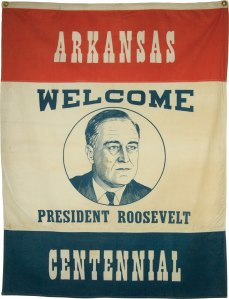
Gov. & Mrs. Roosevelt with Sen. Robinson en route to FDR taking oath as president.
On January 30, 1882, future U.S. President Franklin Delano Roosevelt was born. In 1936, he visited Little Rock as part of a statewide tour in conjunction with Arkansas’ Centennial celebration. While in the state he spent time outside of Hot Springs at Couchwood, the vacation home of Arkansas Power & Light founder Harvey Couch, who was the chair of the Centennial activities.
In honor of President Roosevelt’s visit, a portion of Highway 365 in Little Rock was designated Roosevelt Road. He followed part of that road while in the Capital City before making a public appearance.
President Roosevelt’s address on June 10, recounted Arkansas’ territorial and statehood history. At the end he paid tribute to his Senator Joseph Taylor Robinson. The Senator was a friend and confidant who often led the charge for FDR programs in congress. Indeed, it would be New Deal programs which would allow for the construction of a municipal auditorium in Little Rock, which would be named in memory of Sen. Robinson after his death in the summer of 1937. (As the Democratic leader of the Senate, it had been Robinson who accompanied FDR and Eleanor in the motorcade to the 1933 Presidential inauguration ceremony.) A quote by President Roosevelt upon learning of Senator Robinson’s death adorns a wall of Robinson Center.
 FDR’s visit to Arkansas had political implications as well. The late Senator Huey Long of neighboring Louisiana had been arguably FDR’s biggest adversary in Washington. Long was very popular in rural areas of Arkansas and had campaigned for Hattie Caraway when she ran for re-election to the Senate, to the dismay of many of Arkansas’ Democratic establishment. Harvey Couch had worked to bring about a detente between FDR and Long prior to the latter’s assassination in 1935. But between a lingering mistrust of FDR by Long supporters and discontent from some sectors based on New Deal programs, it was important for FDR to shore up Democratic support in Arkansas. At the time the state had nine electoral votes.
FDR’s visit to Arkansas had political implications as well. The late Senator Huey Long of neighboring Louisiana had been arguably FDR’s biggest adversary in Washington. Long was very popular in rural areas of Arkansas and had campaigned for Hattie Caraway when she ran for re-election to the Senate, to the dismay of many of Arkansas’ Democratic establishment. Harvey Couch had worked to bring about a detente between FDR and Long prior to the latter’s assassination in 1935. But between a lingering mistrust of FDR by Long supporters and discontent from some sectors based on New Deal programs, it was important for FDR to shore up Democratic support in Arkansas. At the time the state had nine electoral votes.
Earlier, President Roosevelt had sent a letter to be read at the grand opening of the Museum of Fine Arts in City Park (a forerunner to the Arkansas Arts Center). That facility was constructed with New Deal dollars.
FDR would return to Central Arkansas in 1943 to review troops at the military facility named for Sen. Robinson. That would be his final visit to Arkansas before his death in April 1945.
As a character in the musical Annie, FDR has been on the stage of Robinson on numerous occasions.

 On December 5, 1933, Ohio, Pennsylvania and Utah provided the necessary support to officially repeal “the great experiment.”
On December 5, 1933, Ohio, Pennsylvania and Utah provided the necessary support to officially repeal “the great experiment.” On October 25, 1905, President Teddy Roosevelt, recently elected to a four year term in his own right, made an appearance in Little Rock.
On October 25, 1905, President Teddy Roosevelt, recently elected to a four year term in his own right, made an appearance in Little Rock. On Tuesday, October 5, 1937, the Fine Arts Club of Little Rock held its first meeting in the new Museum of Fine Arts. But it was not a typical meeting. It was an Open House and Dedication for the new building.
On Tuesday, October 5, 1937, the Fine Arts Club of Little Rock held its first meeting in the new Museum of Fine Arts. But it was not a typical meeting. It was an Open House and Dedication for the new building.
 On August 27, 1944, the first USS Little Rock was launched in Philadelphia at the Cramp Shipbuilding Company shipyards. A 10,000 ton Cleveland Class light cruiser, it first touched water in the Delaware River.
On August 27, 1944, the first USS Little Rock was launched in Philadelphia at the Cramp Shipbuilding Company shipyards. A 10,000 ton Cleveland Class light cruiser, it first touched water in the Delaware River. Future Senator Joseph Taylor Robinson was born in Lonoke in August 26, 1872. In 1894 Robinson was elected to the Arkansas General Assembly for one term. From 1903 until 1913, he served in the US House of Representatives as a Congressman from Arkansas’ then-Sixth District.
Future Senator Joseph Taylor Robinson was born in Lonoke in August 26, 1872. In 1894 Robinson was elected to the Arkansas General Assembly for one term. From 1903 until 1913, he served in the US House of Representatives as a Congressman from Arkansas’ then-Sixth District.